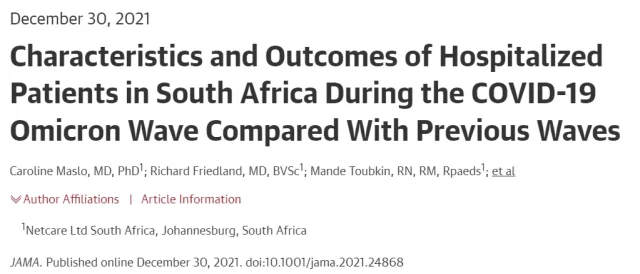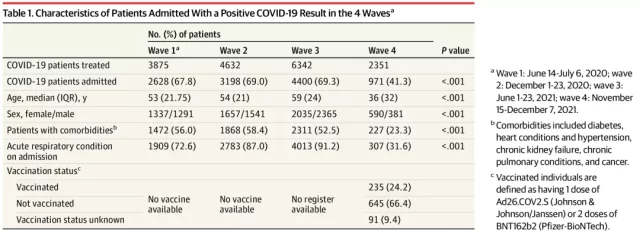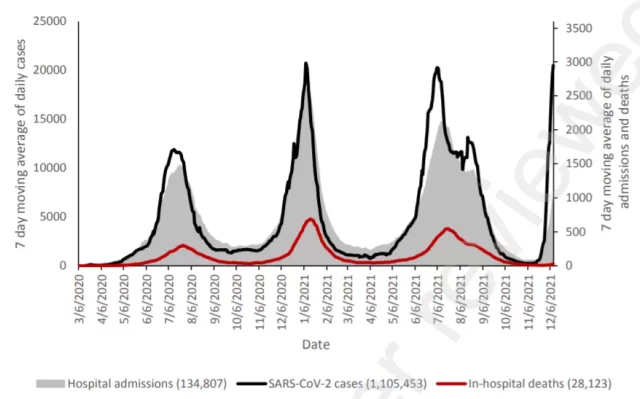New discovery on Omicron: More likely to infect young people!
- Normal Liver Cells Found to Promote Cancer Metastasis to the Liver
- Nearly 80% Complete Remission: Breakthrough in ADC Anti-Tumor Treatment
- Vaccination Against Common Diseases May Prevent Dementia!
- New Alzheimer’s Disease (AD) Diagnosis and Staging Criteria
- Breakthrough in Alzheimer’s Disease: New Nasal Spray Halts Cognitive Decline by Targeting Toxic Protein
- Can the Tap Water at the Paris Olympics be Drunk Directly?
New discovery on Omicron: More likely to infect young people!
- Should China be held legally responsible for the US’s $18 trillion COVID losses?
- CT Radiation Exposure Linked to Blood Cancer in Children and Adolescents
- FDA has mandated a top-level black box warning for all marketed CAR-T therapies
- Can people with high blood pressure eat peanuts?
- What is the difference between dopamine and dobutamine?
- How long can the patient live after heart stent surgery?
New discovery on Omicron: More likely to infect young people!
As the mutant Omicron swept the world, South Africa announced for the first time: “Cancel the curfew” and other epidemic prevention measures.
South African scientists took the lead in the world to report and discover Omicron. Since then, the strain has spread widely, causing the number of infections in countries such as the United Kingdom, France and the United States to continue to hit new highs, and many countries have tightened public health measures.
But now, “all indicators show that South Africa has passed the fourth wave of the epidemic at the national level.” The number of new cases and hospitalizations in the provinces has declined. At the same time, the fourth wave of the epidemic did not cause a significant increase in the death toll.
Farid Abdullah, Director of the Office of AIDS and Tuberculosis Research of the South African Medical Research Council (SAMRC) , posted on social media “Twitter” that the current round of the epidemic came and went quickly, and was not as severe as the mutant strain Delta. . “It took only 4 weeks to reach the peak, and then there was a sharp drop in the next 2 weeks.”
In the third month of Omicron’s appearance, scientific research also frequently appeared in the newspapers. Some studies from different medical systems, different countries, and different ethnic groups have found clinical manifestations such as younger and milder symptoms of Omicron infection.
The infected are younger
On December 30, 2021, JAMA published the first peer-reviewed retrospective study on the clinical manifestations of people infected with Omicron. This article was completed by Netcare, a consortium of private medical institutions in South Africa.

Research points out that South Africa has experienced 4 waves of epidemics from 2020 to now. include:
In the first wave, from June to August 2020, the original strain is the main epidemic strain;
In the second wave, from November 2020 to January 2021, the mutant strain Beta came from behind and became the main epidemic strain;
In the third wave, from May to September 2021, the mutant strain Delta won, causing a pandemic;
In the fourth wave, after November 15, 2021, with the detection of the mutant Omicron, the number of infections surged again.
Based on the progress of the epidemic, Netcare researchers extracted data at the peak of admission in each wave of epidemics, and focused on analyzing the conditions of hospitalized patients in the third and fourth waves.
The results showed that in the peak period of Omikeron infection, the infected were generally younger, with a median age of only 36 years, and most of them were women.
In the third wave of the epidemic dominated by the mutant strain delta, the median age of the infected person was 59 years old, which was the “oldest” of the 4 waves.

Earlier, SSRN released a study on the preprint of The Lancet, which also suggested that Omicron may be more dangerous to young people.
The study analyzed 18,817 Omicron who tested positive and admitted to the hospital, and found that 1,151 people were 20 years old and younger, accounting for 17.68%. During the peak period of delta transmission, 3.8% (161/4,217) were infected and hospitalized in the same age group .
Symptoms of infection are mild
In addition to age characteristics, the above studies are all concerned about the virulence of Omicron.
The WHO has previously issued a warning that the superposition of Delta and Omicron variants will cause a “tsunami” of infection, which will overwhelm the medical and health systems of various countries.
However, data from the South African Ministry of Health show that Omicron has become the main local epidemic strain, causing a sharp increase in the number of hospital admissions, but the growth rate is far less than expected.
Compared with the first wave of the outbreak in South Africa, the odds of Omicron being admitted to the hospital are about 30% lower.

South Africa’s COVID-19 pneumonia data table from March 6, 2020 to mid-December 2021.
The gray is the number of hospitalizations diagnosed with COVID-19; the black curve is the number of new infections; the red curve is the number of hospital deaths. /SSRN
In the JAMA article, the researchers further analyzed the prognosis of hospitalized patients and found that multiple data support “decreased virulence.”
First of all, the hospitalization rate and the average length of stay were significantly reduced. In the first three waves of the epidemic, 68%-69% of the infected people will be admitted to the hospital.
By the fourth wave of the epidemic, the admission rate dropped to 41.3%.
At the same time, the median length of hospital stay for people infected with Omikeron has dropped to 3 days from the previous 7-8 days.
Second, the rate of oxygen inhalation and mechanically assisted ventilation decreased. Especially the latter, from 12.4% in the third wave of the epidemic to 1.6% now.
Thirdly, the complications of infected patients have been significantly reduced, and the fatality rate has dropped sharply.
When Delta is the main epidemic strain, 29.9% of patients need to be transferred to intensive care, and the case fatality rate is 29.1%.
After the Omicron pandemic, the ICU rate of infected persons was 18.5%, and the case fatality rate was 2.7%.

The research on the preprint of The Lancet also makes a similar statement. Researchers said that in the fourth wave of the epidemic, 28.8% of hospitalized cases were severe.
In the second wave and the third wave, the severe illness rates were 60.1% and 66.9%, respectively.
On January 1, 2022, Houston Methodist, one of the largest medical systems in Texas, the United States, also uploaded a paper on the clinical manifestations of Omicron on the preprint platform medRxiv.
The conclusion is the same as that of South Africa Netcare published on JAMA .
Almost the same: it is observed that infected persons are significantly younger, have shorter hospital stays, require fewer respiratory support, and are less severely ill.
The dawn of the end of the epidemic is beginning?
At the beginning of Omicron’s appearance, the medical and scientific circles were concerned mainly because the mutant strain carried a large number of mutations, which were all located on the spike protein.
This makes the virus more infectious. A study in South Africa suggested that the reinfection rate of Omicron was three times higher than that of other strains.
Fortunately, Omicron’s virulence seems to be weakening. Related research and analysis say that this may be the result of a combination of multiple factors.
First, including some animal models, the lung toxicity of Omicron has decreased. According to a study by Imperial College in the UK, it seems to be more likely to infect the upper respiratory tract, especially the susceptible nasal mucosa.
It is no longer as easy to infect the lungs as the earlier strains such as Delta.
A Japanese-US joint preprint study showed that experimental mice infected with Omicron had less lung damage.
Another study in Belgium also reached a similar conclusion. In addition, Hong Kong, China, used lung tissue samples collected from patients with the COVID-19 during surgery to conduct research and found that Omicron grew slower in these samples than other strains.
This may mean that the severe rate of Omicron infection has decreased. But because the virus replicates more frequently in the upper respiratory tract, it also makes it easier to spread.
Second, Bloomberg quoted research saying that T cells and B cells, the second line of defense of the immune system, can still recognize and attack Omicron.
“Virus” published an article on January 2, 2022 that the Hong Kong University of Science and Technology and the University of Melbourne, Australia, have worked together to analyze more than 1,500 new coronavirus protein gene fragments, which can be recognized by T cells produced by patients who have recovered from the new coronavirus and vaccinated.
The results showed that Omicron could hardly escape the attack of T cell immune response through mutation. This shows that the T cell immune response produced by vaccination or natural infection can still protect the human body from severe illness.
Omicron or “New Pandemic”
The WHO is concerned that the South African study may not have “global reference.”
This is related to the demographic structure of South Africa. “The population of South Africa is relatively young, with a median age of 27.6 years.
The United Kingdom is 40.5 years old. Therefore, the Omicron epidemic experienced by South Africa may be different from that of countries with aging populations.” The BBC reported.
Secondly, the vaccination rate in South Africa is relatively low, only 26% of the population is fully vaccinated, and the vaccination rate for people over 60 years old is the highest, reaching 58.4%; followed by 40-59 years old (54.3%) and 20-39 years old (31.7) %) .
The preprint study of The Lancet stated that during the study period, only 5.8% of children under 20 had received the COVID-19 vaccine.
This may be the reason why young people in this country are more susceptible to Omicron.
The prevalence of chronic underlying diseases in young people is low.
Even if they are infected, the severity and progress of the disease will be significantly better than those in the elderly.
“The New York Times” popular science writer Karl Zimmer also agrees that Omicron’s clinical manifestations are lighter.
However, due to its rapid spread and strong infectious power, this will cause more infections.
Therefore, even if the rate of severe illness is low, it may put tremendous pressure on the medical system.
He also pointed out that the popularity of Omicron is more like a “new trend.” The incubation period is extremely short, and the patient will soon have clinical manifestations after infection.
From a public health perspective, if people infected with Omicron can be quarantined quickly after they develop symptoms, the epidemic can be more effectively alleviated.
However, up to now, many countries such as the United Kingdom and the United States have updated their epidemic prevention strategies, shortening or even canceling some quarantine requirements. In the United States, close contacts who have been vaccinated at full doses and have no symptoms do not need to be quarantined, but must wear a mask when performing daily activities for 10 consecutive days.
The Wall Street Journal also warned that the European and American countries that are battling Omicron may not be able to reproduce the experience of South Africa.
In addition to age composition, natural infections, etc., we must also pay attention to seasonal factors. “South Africa is in the summer, and the COVID-19 virus tends to spread more easily in winter-this is the current situation that Europe and the United States are experiencing.”
Reference:
1.Characteristics and Outcomes of Hospitalized Patients in South Africa During the COVID-19 Omicron Wave Compared With Previous Waves. JAMA. doi:10.1001/jama.2021.24868
2.SARS-CoV-2 T Cell Responses Elicited by COVID-19 Vaccines or Infection Are Expected to Remain Robust against Omicron. Viruses. doi.org/10.3390/v14010079
3.South Africa says Omicron wave may have peaked. BBC
4.Omicron threat has a silver lining? Cases soar but new data puts end in sight. mint
5.Omicron cases less severe than other waves, hospitalisation rate lower, shows study in Lancet. The Print
6.COVID-19 Omicron wave in South Africa characterized. Medical Press
7.Clinical Severity of COVID-19 Patients Admitted to Hospitals in Gauteng, South Africa During the Omicron-Dominant Fourth Wave. SSRN. doi.org/10.2139/ssrn.3996320
8.Early signals of significantly increased vaccine breakthrough, decreased hospitalization rates, and less severe disease in patients with COVID-19 caused by the Omicron variant of SARS-CoV-2 in Houston, Texas. medRxiv. doi.org/10.1101/2021.12.30.21268560
New discovery on Omicron: More likely to infect young people!
(source:internet, reference only)
Disclaimer of medicaltrend.org
Important Note: The information provided is for informational purposes only and should not be considered as medical advice.



